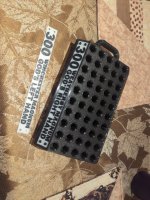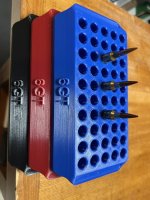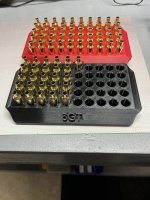You are using an out of date browser. It may not display this or other websites correctly.
You should upgrade or use an alternative browser.
You should upgrade or use an alternative browser.
Reloading room upgrades
- Thread starter crowellsr
- Start date
Nice, I love what the 3D printer can do for the shop and reloading.
I designed a double sided reloading tray for my Bro at Christmas.
Magnum on one side and standard on the other.
For entertainment I added replaceable panels on both sides to give it a personal flair.
Turned out nice enough I printed one for myself, I still haven't nailed down what to put on the panels though...
I designed a double sided reloading tray for my Bro at Christmas.
Magnum on one side and standard on the other.
For entertainment I added replaceable panels on both sides to give it a personal flair.
Turned out nice enough I printed one for myself, I still haven't nailed down what to put on the panels though...

Yeah everytime I sit down in there I seem to come up with something new to printNice, I love what the 3D printer can do for the shop and reloading.
I designed a double sided reloading tray for my Bro at Christmas.
Magnum on one side and standard on the other.
For entertainment I added replaceable panels on both sides to give it a personal flair.
Turned out nice enough I printed one for myself, I still haven't nailed down what to put on the panels though...View attachment 970196
NZClaybuster
CGN frequent flyer
- Location
- Calgary, Alberta
So KOOL ! Thought about one for a long time, but me and my health are winding down now @ 65+ !
Guys..are these 3D printers all under a grand or are they like all 1- 4 Grand... printers ?
Does the plastic line used vary much in price...im thinking yes.
Guys..are these 3D printers all under a grand or are they like all 1- 4 Grand... printers ?
Does the plastic line used vary much in price...im thinking yes.
Like any hobby you can do a little or go overboard...always someone to take your money.So KOOL ! Thought about one for a long time, but me and my health are winding down now @ 65+ !
Guys..are these 3D printers all under a grand or are they like all 1- 4 Grand... printers ?
Does the plastic line used vary much in price...im thinking yes.
Mine is right at a grand and I want one that's a little over $4k. Do I need it, no. Do I want it, yes. Will I get it, maybe, maybe not.
Filament prices can vary but only if you get carried away with engineering grade products.
And knowing what you intend to print and how you intend to use those products is the first cornerstone in choosing a printer.
Next is size, how big do you realistically need to print?
And last, do you need to print in more than 1 color.
These three constraints will define your budget.
PLA is non toxic and super easy to print, with a moderate sized bed there are excellent multicolor options well under a grand and easy to turn out impressive products. Their drawbacks only come out when you start playing with different filaments; PLA is brittle, doesn't like UV and has a low temperature resistance.
Other filaments offer much better characteristics but come at the cost of toxicity, harder to print and increased hardware and consumable costs.
Personally I'm gravitating towards more use of PETG but I purchased an enclosed printer with filter and have an area I can use it away from the house.
Long story short; totally worth it, but buy an enclosed as big as affordable, start with easy PLA and branch out.
At the moment if budget is a thing I'd consider a Creality K1C as a good start. Anything Bamboo is excellent but very closed source and seems to be getting worse which is why I don't have one.
For reference I have a Creality K1Max that's had multiple upgrades and the printer I want is a Prusa 5 head XL (wish me luck, or sanity..).
No idea on those trays but most slicers (the program that takes the 3D model and tells the printer how to do it) have the functionality to plug in your material cost and it will calculate a total cost of material based off how many grams it requires.What does it cost for you to make those trays?
Now this doesn’t include hardware costs (printer/computer) , energy required or failed attempts.
Material cost is also highly dependent on how you decide to print the model; adding base, wall and top layers or increased infill will add grams to the build.
Choosing slower print speeds or finer resolution also extends print time so will cost in energy and lower machine productivity (if that matters to you).
Most multicolor printers also waste a ton of material switching colors and can massively add to material costs.
Engineering grade materials can amplify cost considerably as well, however most people don’t require them for items like this.
For reference my block is large and with thick external surfaces and high infill so it’s pretty heavy, around 750 ish grams and would run around $15 to print in PLA. +/- depending on the deal you got when you bought your material.
A basic light single block in PLA I’d guess it would be possible to duplicate for around $5 in materials, maybe less.
Add hardware or time to that and it’s a hobby…
warpage really depends on the material, printer and skill of the person printing in selecting the right settings.3D printing is the least efficient way to produce loading blocks. It is super slow for items that size. Warping on large, flat shapes is also a problem.
3D printing is awesome for a lot of tools and storage trays / blocks etc.
Once you know what to do on your printer for a given material warpage can be eliminated…within the limitations of your printer.
My block never warped but that’s only because I learned on several other large models what to do, and not do.
Primer catch, now there is a great idea.
Anybody looking for decent printer, I got a Creality Hi combo a while ago, was just under $700. Seems like pretty good value and don't have to fart around with discovering the sweet spot like you may have to with an open source machine (except doesnt like TPU). Was an upgrade from a 10 year old prusa knockoff amazon special. Up and printing in less than an hour, right out of the box, self bed leveling, auto calibration, super simple filament change, slicer is a bit of a learning curve but basically simple. Printers have come a long way.
It depends on the colours, multi colour etc. I sell them for around 15What does it cost for you to make those trays?
They don't take that long to print and if petg is warping you have other issues3D printing is the least efficient way to produce loading blocks. It is super slow for items that size. Warping on large, flat shapes is also a problem.
3D printing is awesome for a lot of tools and storage trays / blocks etc.









































































